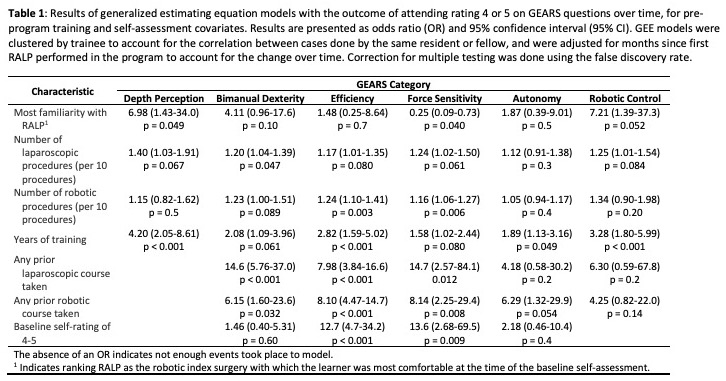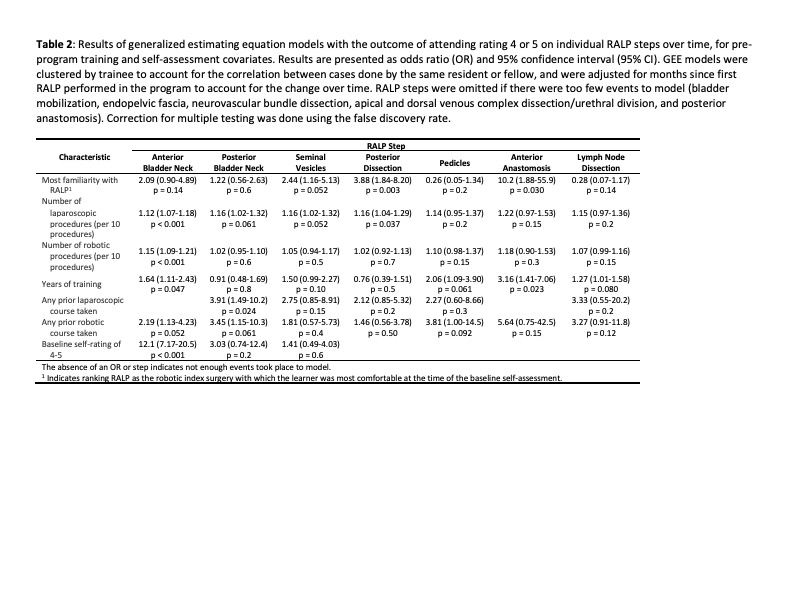Back
Poster, Podium & Video Sessions
Moderated Poster
MP19: Education Research II
MP19-19: Predicting proficiency during robotic prostatectomy of urology trainees using a novel, systemic surgical training program
Saturday, May 14, 2022
7:00 AM – 8:15 AM
Location: Room 228
Rand Wilcox Vanden Berg*, Ashwin Ramaswamy, Emily Vertosick, Eugene Cha, Jonathan Coleman, Timothy Donahue, James Eastham, Behfar Ehdaie, Vincent Laudone, Eugene Pietzak, Robert Smith, Alvin Goh, New York, NY
- RW
Poster Presenter(s)
Introduction: Traditionally, learners in surgical education are evaluated without a structured, proficiency-based approach. Through using a longitudinal, standardized, structured evaluation system we aim to describe the baseline characteristics associated with achieving proficiency while learning the steps of robotic prostatectomy (RALP) and robotic surgical skill acquisition.
Methods: Trainees were enrolled in the experience tracking program with baseline self-assessments administered. After each RALP, a survey was completed independently by the trainee and attending: RALP was divided into 12 steps based on expert consensus and performance was rated on a 5-point anchored Likert scale (1 novice - 5 expert); technical skills were assessed using the Global Evaluative Assessment of Robotic Skills (GEARS). We assessed association of baseline characteristics were improvements in attending ratings over time (achieving a 4 or 5). Generalized estimating equation (GEE) models were created for each RALP step and GEARS question for covariates of interest.
Results: Between July 2020 and June 2021, 6 fellows, 8 residents, and 9 attendings participated. 250 training cases were available for analysis (72% and 77% completion rate, trainees and surgeons, respectively). Fellows performed more steps/case than residents, median (IQR) 5 (3-7) and 3 (2-4), respectively, p<0.01. Association between the covariates and GEARS are presented in Table 1 and with RALP steps in Table 2. Internal consistency for GEARS for trainees, attendings, and overall was 0.96, 0.88, and 0.93 (Cronbach’s a), respectively. Interrater reliability for GEARS performance was 0.76 (Kendall’s W).
Conclusions: A structured, surgical experience tracker can assess performance with good participation, internal consistency, and agreement amongst learners and attendings. Formal courses were associated with higher achievement in both GEARS scores and on various steps of RALP, suggesting that their inclusion in curricula could increase skill acquisition for trainees.
Source of Funding: None


Methods: Trainees were enrolled in the experience tracking program with baseline self-assessments administered. After each RALP, a survey was completed independently by the trainee and attending: RALP was divided into 12 steps based on expert consensus and performance was rated on a 5-point anchored Likert scale (1 novice - 5 expert); technical skills were assessed using the Global Evaluative Assessment of Robotic Skills (GEARS). We assessed association of baseline characteristics were improvements in attending ratings over time (achieving a 4 or 5). Generalized estimating equation (GEE) models were created for each RALP step and GEARS question for covariates of interest.
Results: Between July 2020 and June 2021, 6 fellows, 8 residents, and 9 attendings participated. 250 training cases were available for analysis (72% and 77% completion rate, trainees and surgeons, respectively). Fellows performed more steps/case than residents, median (IQR) 5 (3-7) and 3 (2-4), respectively, p<0.01. Association between the covariates and GEARS are presented in Table 1 and with RALP steps in Table 2. Internal consistency for GEARS for trainees, attendings, and overall was 0.96, 0.88, and 0.93 (Cronbach’s a), respectively. Interrater reliability for GEARS performance was 0.76 (Kendall’s W).
Conclusions: A structured, surgical experience tracker can assess performance with good participation, internal consistency, and agreement amongst learners and attendings. Formal courses were associated with higher achievement in both GEARS scores and on various steps of RALP, suggesting that their inclusion in curricula could increase skill acquisition for trainees.
Source of Funding: None



.jpg)
.jpg)